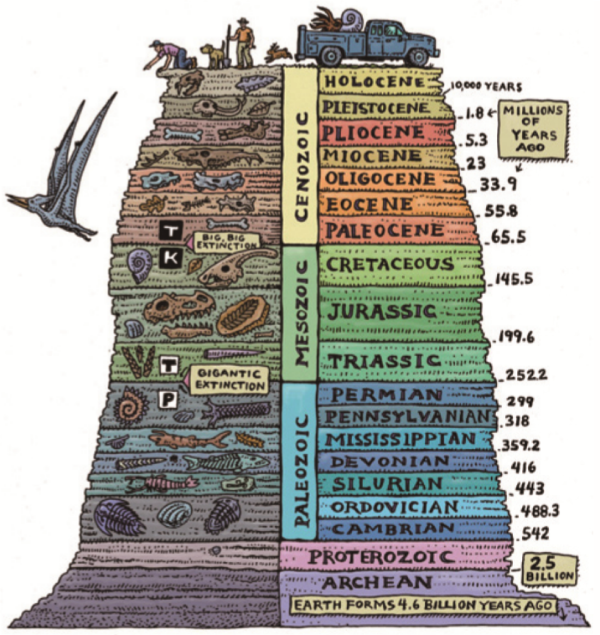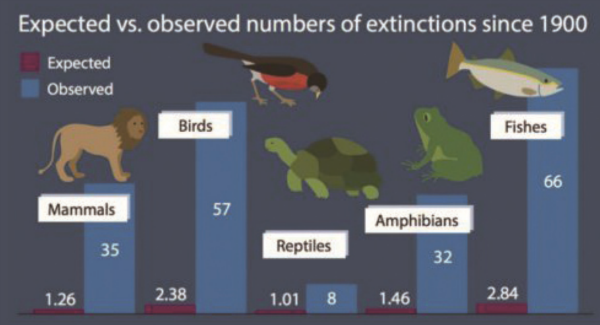Environmental pollution has been one of the most important issues in modern society for a long time. It is a topic that might be taken lightly by people who are living in the present; however, it is never awkward to stress its importance. As the influence of mankind on the Earth has grown enormously since the 18th century, voices insisting on the designation of the ‘Anthropocene’ as a new geographical age began to rise in the early 2000s. The ‘Anthropocene’ era is an idea initially introduced by Nobel Prize winner Paul Crutzen although it is not accepted as an established theory in academia just yet. The discussions on whether to accept it or not, however, are still going on. As the 22 nd April is Earth Day, the Sungkyun Times (SKT) would like to introduce and analyze the idea of the ‘Anthropocene’ age.
Introduction and Features of the Anthropocene
What is the Anthropocene?
The Anthropocene is a compound word of ‘anthropo’ which means mankind and ‘cene’ which means epoch. It was proposed for the first time in 2000 by Paul Crutzen, a Dutch chemist who won the Nobel Prize for Chemistry in 1995. Crutzen said that it is necessary to classify ‘Anthropocene’ as a geographical age since a new age has started on Earth due to the developed activities of humankind. It is also an idea to argue that it is not enough to define Earth’s current status which went through a radical change during the past few centuries, as the same geological time frame as the Holocene which started 12,000 years ago. In order of Earth’s major epochs, the Anthropocene is a new era that follows the Holocene, the last period of the Cenozoic era, which continued for the past 17,000 years when the last glacial epoch ended. If the Anthropocene gets its recognition, it means that humankind has left its trace in the stratum of the Earth. It also refers to an age where mankind fights against the environment, counting the cost of the damage it has made to the environment.

Features of the Anthropocene Era
The biggest characteristic of the Anthropocene is the destruction of nature caused by human activities. Up to now, humans had endlessly damaged and destroyed nature, so currently they are facing an environment that is totally different with the settled and tame one where they have evolved. Because of climate change caused by global warming and the El Niño effect, the environmental system of the Earth such as its physics, chemistry, and biology has changed fundamentally. Radioactive substances exist as a result of nuclear bomb experiments, and the concentration of the carbon dioxide in the atmosphere is not negligible. Moreover, waste that had never been an issue in the past such as aluminum, plastic, and concrete are piling up in the geological layers.
The most terrible scene of the Anthropocene, however, is the sixth mass extinction. Scholars are expressing their concern that species are becoming extinct at a pace faster than any other mass extinction in the past, and some of them are analyzing that the sixth mass extinction is already in progress on Earth. According to the Center of Biological Diversity in the United States, mankind is facing the most severe mass extinction situation since the fifth mass extinction that made all the dinosaurs disappear 65 million years ago. The organization also said that the pace of the current extinction is estimated to be 1,000 to 10,000 times faster than that of the past. Approximately 41% of amphibians, 26% of mammals, and 13% of fowl are endangered today. Just as the dinosaurs disappeared and left their bones in fossils, humans are likely to become extinct as well, leaving their plastic bottles and aluminum cans as evidence of their existence.

Mixed Views of Scientists Surrounding the Anthropocene
When did the Anthropocene begin?
Geographical ages have previously been determined by crustal movements and the changes of climate, but the starting point of the Anthropocene age is still ambiguous. Some scientists argue that the Anthropocene started from the Neolithic Age because the ocean, atmosphere, and environment started to change radically as mankind started to engage in farming. This opinion, however, makes the Anthropocene the same as the Holocene age, so it did not attract great attention. Some other scientists insisted that the Anthropocene started right after the Industrial Revolution in the 18th century. They highlight that extinct species after the Industrial Revolution outnumber those before it. Indeed, the current pace of extinction is faster than the third mass extinction, the biggest one in history when 95% of the world’s species disappeared.
Because geographical ages cannot be classified only by extinction, contention that the Anthropocene started in the mid-20th century when nuclear bomb experiments were taking place is the most powerful voice at the moment. In order to divide a geographical epoch, a distinctive feature of the layer should be identified so that certain creatures in the future or intelligent beings from outer space would be able to recognize its distinction. Radioactive fallout from worldwide nuclear tests and technofossils such as plastic and concrete are accumulating and have been leaving their mark in the stratum since the 1950s, becoming a peculiar feature of the Anthropocene.

Should academia accept the Anthropocene as an official geographical epoch?
After Crutzen introduced the concept of it in 2000, the idea of the Anthropocene had a great influence on academia. More than 200 international academic journals published articles dealing with the Anthropocene, and Elsevier, a global publishing company of science and technology articles, started to publish a new academic journal named the ‘Anthropocene’. In August 2004, scientists from each field participated in the EuroScience Forum held in Stockholm, Sweden, and supported the Anthropocene theory. Some people are in favor of the Anthropocene; however, skepticism still exists in the field. Geologist Whitney Autin from the State University of New York College at Brockport said, “There should be a distinct layer different from the former era in order to name a new geographical era, but it is not enough to demonstrate the Anthropocene yet.” Professor Kitasato Hiroshi from Tokyo University of Marine Science and Technology also said, “The matter of who caused the Anthropocene becomes a problem if the Anthropocene is accepted, and that may continue to a political battle beyond pure scientific discussion.” In other words, it may cause political problems within society.
The geographical epoch of today is officially acknowledged by the International Union of Geological Sciences (IUGS) as the Holocene. IUGS launched the Anthropocene Working Group in 2009 to discuss the Anthropocene and determine whether it has arrived or not by the end of 2016, but they have not announced their official position yet.
Worldwide Movements Relating to the Anthropocene
Discovery of Anthropocene Equation

A joint research team between Australia and Sweden led by Professor Will Steffen from Australian National University developed the ‘Anthropocene equation’ that calculates the influence of human activities on the climate. By comparing variables such as volcanic eruptions and the change of the Earth’s orbit through the equation, the team drew the conclusion that mankind has accelerated the speed of global warming by 170 times. For the last 4.6 billion years of the Earth’s history, human activities have changed the temperature of the Earth more rapidly than any other factor. For the past 7,000 years, the standard pace of temperature change of the Earth was a gradual temperature decrease by 0.01℃ every century. During the past 45 years when human activities such as the use of fossil fuels and deforestation were vigorous, however, the temperature of the Earth increased by about 1.7℃ on a one hundred year basis. The team mentioned that even though the simple form of the equation cannot express numerous data, they wanted to show how rapidly humans changed the climate.
Human Technologies Being Used to Prevent Mass Extinction

High technologies such as the Internet of Things (IoT) and machine learning are being used in endangered species research. A research team of Murdoch University in Australia is utilizing drone and machine learning for ecological study of the dugong, an endangered marine mammal. Instead of tracing the dugongs by a small plane, they took about 45,000 aerial photographs by drone to capture the dugongs that came up to the surface of the water to breathe. It was impossible to distinguish every single dugong from the 45,000 aerial photographs, so they got help from the Artificial Intelligence research team of the University of Queensland and used machine learning, a technology used for attempting to predict the future by analyzing massive data. The machine learning designed for the dugong research presented about an 80% accuracy reading even though it was an early version. In addition, joint research teams including George Washington University and Michigan State University in the US developed and employed a face recognition system named ‘LemurFaceID’ in a study based on the prevention of primate extinction. This system showed a 98.7% accuracy reading for the entity recognition of over 400 pictures of 80 lemurs in Madagascar. It also enables ecological research without marking up the lemurs and can be used on research of other wild animals such as bears and red pandas.
Tasks Given to Our Generation
Hereafter The advent of the Anthropocene in the geographical chronology might not have a great influence on our daily lives, but it is important for us to be concerned because it contains great meaning. Mankind should not overlook the influence of human activities on the Earth anymore and should try its best to minimize environmental pollution and reinstate the nature that they have destroyed. Although there have been numerous international environmental treaties such as the Kyoto Protocol, the Montreal Protocol, and the Rio Conference, the reality is going in the opposite direction of global promises. The concentration of carbon dioxide in the atmosphere is still increasing and marine pollution never seems to decrease. Air pollution was ranked fifth as the global cause of death in 2015 with about 4.2 million deaths, and the World Health Organization (WHO) said, “1.7 million children under five die every year because of environmental pollution.” Whether humans will be recorded as an extinct species in the future just like dinosaurs or prolong the history of humankind depends on the decisions made by present generation. Now, it is time for actual movement rather than promises merely written on paper.

There is no use crying over spilt milk. Right now, mankind is dangerously holding up a cup named ‘Healthy Earth’ which is full of milk. Even though it is quite dangerous, we still have a chance to save the Earth because the milk is yet to be spilt. Before the Earth becomes impossible to recover, we should do our best to minimize pollution and give the Earth a chance to restore itself. Maybe the advent of the Anthropocene might be another chance given to mankind to make Earth more beautiful. As members of Earth’s society who are living in the present age, the SKT hopes that Kingos will become more concerned about environmental problems and take care of nature in everyday life.
